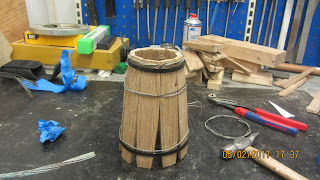The three larger windows will be at the ground floor, and the two smaller windows will be for the attic. One in each gable.
For once this was a project that could benefit from my shaper. That thing is a beast when it comes to making large rabbets and long pieces of mouldings.
Traditionally frames are made with mouldings on the stiles and none on the rails. But I wanted to have mouldings all the way around.
I dovetailed the frames together, and in order for the moulding to flow around the corner I used a mitered dovetail for the outermost part of the frame.
The technique isn't terribly hard to learn or do, so it went together fairly well. My biggest challenges were that the stock was thick, but a bit of concentration during sawing helps a lot.
During the last couple of days I have been trying to make the window casements. There will be a total of 8 casements, so in order to make some progress, I am making it mainly as a power tool build.
The stock for the window casements are larch that I milled two years ago. It was originally intended to become a fence around the porch, but in the end we decided that a fence wasn't needed, so I could use them for this project instead.
I again used the shaper for making the rabbets and the mouldings. And this time I have tried to use it for making the bridle joints as well.
There is a special iron that is suitable for making tenons and the open mortises for the bridle joints. I have never used it before, because quite frankly it scares me a bit. The combination of the shaper and that blade is something that will eat a hand or an arm in an instant.
It is a interesting to note that when I have to make multiples, the machines are really fast despite the setting up can be a bit time consuming. A thing that is also interesting to note is the sometimes terrible amount of tear out left behind.
To be fair I think most of it can be traced to the wood. Larch is rather stiff, but it tears out easily.
The first window casement was assembled by means of drawbored dowels. The next one was just pegged after the glue had set. That route allowed me to put a clamp on the bridle joint which I think results in a better joint overall.
A project like this that requires a lot of pegs/dowels, is just what I have been longing for, because it gives me an opportunity to use my BLUM dowel plates. They are nothing short of impressive.
Mitered dovetail joint on window frame.
The spindle shaper with the scary Z blade.
Frames for the large windows.
Blum dowel plate.
























